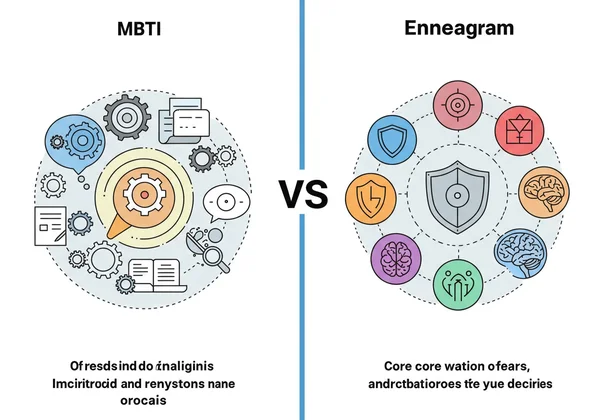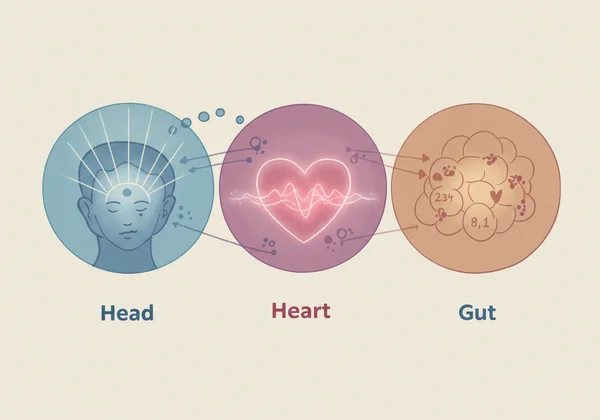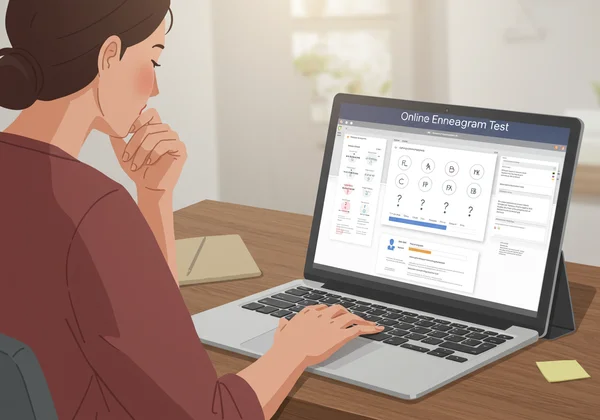Enneagram Test: Your Ultimate Guide to 9 Types & Core Concepts
Have you ever felt like you're searching for a map to understand yourself better? A tool that doesn't just label you but reveals the deeper motivations behind your actions, fears, and desires? If so, you're not alone. Many of us are on a journey of self-discovery, and the Enneagram is a profound and transformative guide. Ready to begin? Let's explore what the Enneagram test is and how it can illuminate your path to personal growth.
The Enneagram is more than just a personality test; it's a dynamic system that uncovers the core beliefs that drive your patterns of thinking, feeling, and behaving. By understanding this framework, you can unlock incredible self-awareness and compassion for yourself and others. If you're ready to start this journey, you can discover your type with our free, insightful Enneagram test.
What is the Enneagram System?
Simply put, the Enneagram is a powerful model of the human psyche, represented by a nine-pointed diagram. Each of the nine points corresponds to a distinct personality type, each with its own worldview and set of motivations. Unlike other personality systems that focus on behavior, the Enneagram delves into the why behind your actions, exploring your fundamental fears and desires.
This powerful tool helps you see the "box" you've unconsciously put yourself in and gives you the keys to step outside of it. It’s a pathway to breaking free from self-limiting patterns and embracing your most authentic self. The Enneagram isn’t about changing who you are, but about becoming more of who you are at your core.

A Brief History and Philosophy of the Enneagram
While the Enneagram symbol has ancient roots, its application to modern psychology is a more recent development. Thinkers like Oscar Ichazo and Claudio Naranjo played a key role in blending ancient wisdom with modern psychology in the 20th century. Their work transformed the Enneagram into the rich, nuanced system for personal and spiritual development that we know today.
The core philosophy is that each of us is born with a unique essence, but as we grow, we develop a personality or "ego" to navigate the world. This personality structure, while helpful for survival, can also limit our potential. The Enneagram illuminates this structure, helping us reconnect with our true essence and live more consciously.
Enneagram vs. MBTI: Understanding the Key Differences
Many people are familiar with the Myers-Briggs Type Indicator (MBTI), so how does the Enneagram compare? The key difference lies in what they measure. MBTI focuses on your cognitive processes—how you perceive the world and make decisions. It describes how your mind works.
The Enneagram, on the other hand, focuses on your core motivations—your deepest fears and desires. It explains why you do what you do. While MBTI gives you a snapshot of your personality traits, the Enneagram provides a dynamic map for growth, showing how you react under stress and how you can move toward health and integration. They are both valuable, but the Enneagram offers a clearer path for personal development.

Understanding the 9 Enneagram Types
The true power of the Enneagram comes from exploring the nine distinct personality archetypes. Each type has a unique way of seeing the world, driven by a specific core motivation. Discovering your type is like being handed a personalized guidebook to your inner world.
While a comprehensive online enneagram test is the best way to start, here is a brief overview of what drives each of the nine types. Remember, no type is better or worse than another; each has unique strengths and challenges.
Core Motivations, Fears, and Desires for Each Type
- Type 1 (The Reformer): Motivated by the desire to be good and right. Fears being corrupt or defective.
- Type 2 (The Helper): Motivated by the need to be loved and wanted. Fears being unworthy of love.
- Type 3 (The Achiever): Motivated by the desire to be valuable and worthwhile. Fears being worthless.
- Type 4 (The Individualist): Motivated by the need to be unique and authentic. Fears having no identity or significance.
- Type 5 (The Investigator): Motivated by the desire to be competent and capable. Fears being helpless or incompetent.
- Type 6 (The Loyalist): Motivated by the need for security and support. Fears being without support or guidance.
- Type 7 (The Enthusiast): Motivated by the desire to be satisfied and content. Fears being deprived or in pain.
- Type 8 (The Challenger): Motivated by the need to protect themselves and control their own lives. Fears being controlled or harmed by others.
- Type 9 (The Peacemaker): Motivated by the desire for inner peace and harmony. Fears loss and separation.
The Three Centers of Intelligence: Head, Heart, and Gut
The nine types are organized into three groups of three, known as the Centers of Intelligence. Each center represents a primary way we filter our experiences: through thinking (Head), feeling (Heart), or instinct (Gut).
- The Gut/Instinctive Center (Types 8, 9, 1): These types are concerned with control and resistance to reality. Their primary emotion is anger.
- The Heart/Feeling Center (Types 2, 3, 4): These types are focused on their self-image and how others perceive them. Their primary emotion is shame.
- The Head/Thinking Center (Types 5, 6, 7): These types are oriented toward security and managing anxiety. Their primary emotion is fear.
Understanding your dominant center provides deep insight into your automatic reactions and is a crucial step in your self-discovery.

Essential Enneagram Concepts Beyond Your Core Type
Your core Enneagram type is just the beginning. The system's true depth is revealed through its dynamic components, which show that personality is not static. These concepts explain the nuances that make you a unique individual, not just a number.
The Impact of Enneagram Wings
Your "wing" is one of the two types adjacent to your core type on the Enneagram diagram. For example, if you are a Type 9, your wings are Type 8 and Type 1. You will likely lean more heavily on one of these wings, which adds flavor and complexity to your core personality. An enneagram test with wings can provide a much fuller picture of who you are.
Stress and Growth Paths: Arrows of Disintegration and Integration
The lines on the Enneagram diagram are not random; they represent paths of movement. When you are under stress (disintegration), you may take on the negative traits of the type connected by the arrow. Conversely, when you are feeling secure and growing (integration), you take on the positive qualities of the other connected type. These arrows show that you have access to a wide range of traits and that growth is always possible.
Exploring Enneagram Subtypes (Instinctual Variants)
Diving deeper, each of the nine types can be expressed in three different ways, based on our instinctual drives. These are the Self-Preservation, Social, and One-to-One (or Sexual) instincts. This creates 27 distinct enneagram subtypes, each with a unique focus and behavioral pattern. Identifying your subtype adds another layer of precision to your self-understanding.
What is an Enneagram Tritype?
The Tritype theory suggests that while we have a dominant type in one center, we also have a preferred type in the other two centers of intelligence. Your Tritype is the combination of these three types (one from Gut, one from Heart, one from Head), which reveals your unique defense strategy and worldview. An enneagram tritype test can offer even more personalized insights into your personality structure.
How to Accurately Find Your Enneagram Type
Discovering your true Enneagram type is a process of self-exploration. While reading descriptions is helpful, the most effective way to begin is with a combination of objective assessment and honest self-reflection.
The Importance of Self-Observation and Reflection
Ultimately, you are the only one who can determine your Enneagram type. A test can point you in the right direction, but it's crucial to observe your own patterns with curiosity and compassion. Pay attention to your automatic reactions, your daydreams, and what truly motivates you deep down. This inner work is where the most profound insights are found.
Why Take a Comprehensive Online Enneagram Test?
While self-reflection is key, a well-designed accurate enneagram test is an invaluable starting point. It can cut through your biases and highlight potential types you might not have considered. An effective test asks questions that probe your core motivations rather than just surface-level behaviors.
Our free and quick Enneagram test is designed to provide you with an insightful and reliable starting point. After discovering your likely type, you can then delve deeper with our optional AI-powered personalized report, which offers actionable steps for your unique growth journey. Why wait to gain clarity? Take the test now.

Ready to Discover Your Enneagram Type?
The Enneagram is a powerful and compassionate tool for understanding yourself and others. It’s not about putting you in a box but about showing you the box you're already in—and helping you find the way out. This journey of self-discovery can lead to greater self-acceptance, improved relationships, and a more fulfilling life.
Your path to unlocking your potential starts with a single step: discovering your Enneagram type. We invite you to start your journey with our free, comprehensive test. Embrace the opportunity to see yourself more clearly and step into a more conscious and empowered version of you.
Frequently Asked Questions About the Enneagram
What exactly is the Enneagram test, and how does it help me?
An Enneagram test is a personality assessment designed to identify your dominant Enneagram type out of nine. It works by asking questions about your core motivations, fears, and worldview. It helps you by providing a framework for self-understanding, highlighting your strengths, identifying challenges, and offering a clear path for personal growth in your relationships and career.
How accurate is the Enneagram test results you get online?
The accuracy of an online Enneagram test depends on its design and your self-awareness while answering. A good test, like ours, focuses on underlying motivations rather than just behaviors, leading to highly insightful results. It's best used as a strong starting point for self-reflection. For the deepest insights, you can explore our optional, hyper-personalized AI report after taking the free enneagram test.
What are the primary differences between the 9 Enneagram types?
The primary differences lie in their core motivations, fears, and desires. For example, a Type 2 is driven by a need to be loved and fears being unwanted, while a Type 8 is driven by a need to be in control and fears being controlled. These fundamental differences create nine distinct ways of seeing and interacting with the world.
What's the best way to find my true Enneagram type?
The best approach combines an objective assessment with personal reflection. Start by taking a reputable, free Enneagram test to get a strong indication of your likely type. Then, read in-depth descriptions of the suggested types, paying close attention to the core fears and desires. The type that resonates most deeply on a motivational level is likely your true type.
Can the Enneagram really help with my personal growth and relationships?
Absolutely. The Enneagram is a powerful tool for growth because it illuminates your unconscious patterns. By understanding your type, you can work with your challenges more effectively and lean into your strengths. In relationships, it fosters empathy by helping you understand that others have fundamentally different motivations, leading to better communication and less conflict. Get your results and see for yourself.